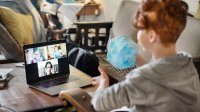Getting Started With PBL in Social Studies
Implementing project-based learning can lead students to investigate historical movements.
Your content has been saved!
Go to My Saved Content.“I have to go to history class? So boring!”
“Why do we have to learn about revolutions we weren’t even alive for?”
These are just some of the comments that I used to hear from my students, and I remember making the same comments myself in high school. When I became a teacher, I wanted to make my class more fun and engaging, and that’s where project-based learning (PBL) came in—PBL is a learning experience in which students investigate real-world problems that interest them and create solutions that demonstrate their learning for a broader audience than their teacher or their class.
PBL requires intensive planning, but it’s worthwhile in my opinion because it fosters great student engagement and requires students to use crucial skills like critical thinking, creativity, collaboration, and communication.
When I wanted to create a PBL unit for my high school Latin American Studies class, I found few example units for my course—there are some good ones at PBLWorks—so I created one myself. This unit takes place over three to four weeks, with hourlong classes twice a week.
I created this project to bring the Latin American revolutions from the dusty pages of textbooks into the 21st century. What makes it a little different from other projects I’ve seen is that I had students role-play as Latin American revolutionaries to gain a historical perspective.
PBL in Social Studies in 5 Steps
1. Create a question for students to answer in their project: The driving question in my unit was how to solve a current problem affecting a Latin American country of the students’ choosing. I gave them this prompt: “You are a 17-year-old revolutionary in your country. You have been given the ability to change one thing in the future in your country for the better. What would you change? How and why would you change it?”
Examining the political, social, and economic causes of past revolutions helped them identify similar problems in 2020. I used the role-play to create buy-in for the students—the perspective encouraged them to take more ownership of finding a feasible solution to make their country better. Students communicated their solutions in a blog or video diary and could work in pairs or groups.
2. Give students time to research: When students were researching their problems and solutions, I provided scaffolds to support learning. These scaffolds could be mini-lectures or videos. To give students an idea of what to look for in their research, I set up whole-class discussions; in distance learning I used the chat function in our video conferencing application, or posted discussion questions in our learning management system. Students created a rubric to assess their projects and set learning goals to hold themselves accountable.
3. Have students organize and visualize their research: Students could use digital graphic organizers to begin plotting what problem they would focus on and brainstorm solutions. They peer-reviewed rough drafts with project rubrics, which could also be completed asynchronously.
This is the point when teachers should organize an authentic audience for students to share their work with, which can be community leaders, families, or others, depending on the project. I didn’t bring in an outside audience this year; students presented to their families and the class.
4. Have students create their stories: I allowed students to choose the applications they would use to create their final products detailing their solution to the problem they hoped to address. They created either a blog or video diary as their authentic products, creating a day-by-day chronicle identifying their problem along with the solution they would put in place, and what effect they hoped the solution would have on their country.
5. Students share their projects: In PBL units, students present their final project to an authentic audience. In distance learning, I had students present live over Zoom; if they weren’t comfortable with that, they could record their presentation as a Flipgrid video. It’s also important to provide a chance for audience feedback about the projects.
We concluded with self-reflection by the students and me, which helped me gauge my students’ thoughts about the project, workflow, and the effectiveness of the lesson. It’s critical for me as a teacher to reflect on what went well and what can be improved upon. I suggest also critiquing the project with your content team for tweaks, so you can fine-tune the goals that you want to accomplish by the end of the project.
PBL creates an engaging student-centered learning experience that allows students to go beyond just facts and deeply explore real-world issues with a focus on creating solutions.
